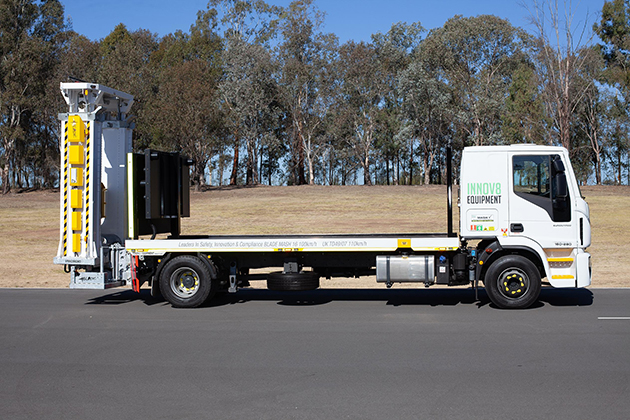Introduction
Work zones are among the most hazardous areas on roads, where accidents can occur due to sudden lane closures, shifting traffic patterns, and distracted drivers. In such environments, truck-mounted attenuators (TMAs) serve as lifesaving equipment, offering a mobile and robust shield against potential collisions. Designed to protect workers, motorists, and equipment, TMAs are indispensable in modern traffic management. This article explores their role, features, and significance in ensuring safety in high-risk areas.
What Are Truck Mounted Attenuators?
Truck-mounted attenuators are impact-absorbing devices attached to the rear of trucks or construction vehicles. Their primary function is to reduce the severity of collisions by absorbing impact energy, thereby minimizing damage to vehicles, workers, and equipment in work zones.
Key Components of TMAs
- Crash Cushion: The core energy-absorbing structure.
- Support Frame: Provides stability and connects the attenuator to the vehicle.
- Lighting and Signage: Enhances visibility to alert approaching motorists.
Importance of TMAs in Work Zones
Worker Safety
TMAs act as physical barriers between oncoming traffic and workers, significantly reducing the risk of injury or fatalities in construction zones.
Motorist Protection
For drivers who may inadvertently enter restricted zones, TMAs help mitigate crash severity, often saving lives.
Equipment Preservation
By absorbing collision forces, TMAs prevent damage to expensive construction equipment and vehicles.
Features of Modern Truck Mounted Attenuators
Impact Absorption Technology
Modern TMAs utilize advanced materials and engineering designs to dissipate collision energy effectively.
High Visibility
Bright colors, reflective surfaces, and integrated LED warning lights ensure that TMAs are easily noticeable, even at night or in poor weather conditions.
Quick Deployment Mechanisms
Hydraulic or manual systems allow for rapid deployment and retraction, ensuring minimal disruption to traffic flow.
Compatibility
TMAs can be attached to a variety of vehicles, including dump trucks, maintenance vehicles, and pilot cars.
How TMAs Work
- Collision Impact: When a vehicle crashes into a TMA, the device absorbs and redistributes the impact energy.
- Energy Dissipation: The crash cushion compresses, reducing the kinetic energy transferred to the striking vehicle.
- Controlled Deceleration: This controlled process minimizes damage and injury to both the motorist and the work zone.
Applications of Truck Mounted Attenuators
Road Construction and Maintenance
TMAs are critical for protecting workers during pavement repair, bridge construction, and roadside maintenance projects.
Emergency Response
They are used by emergency teams to shield accident scenes and create safe zones for responders.
Traffic Control
In urban areas, TMAs are deployed during events or detours to guide and protect traffic flow.
Advantages of Truck Mounted Attenuators
Enhanced Safety
By providing a reliable barrier, TMAs significantly reduce the risk of severe injuries or fatalities.
Cost-Effective
Preventing accidents and equipment damage results in long-term savings for construction firms and government agencies.
Versatility
TMAs are adaptable to various road conditions, including highways, urban roads, and rural settings.
Compliance
Their use aligns with traffic safety regulations and standards, ensuring legal and operational adherence.
Challenges and Innovations in TMAs
Challenges
- High Initial Costs: Advanced TMAs can be expensive to procure and install.
- Maintenance: Regular inspections and repairs are necessary to maintain functionality.
- Driver Awareness: Motorists unfamiliar with TMAs may not respond appropriately to their presence.
Innovations
- Smart TMAs: Integration of IoT sensors for real-time monitoring and data collection.
- Eco-Friendly Materials: Use of sustainable materials to reduce environmental impact.
- Enhanced Mobility: Lightweight designs for easier attachment and deployment.
FAQs about Truck Mounted Attenuators
1. What is the primary purpose of truck-mounted attenuators?
TMAs protect workers and motorists by absorbing impact energy during collisions in work zones.
2. Are TMAs mandatory for all road projects?
Regulations vary by region, but many countries require TMAs for highway and high-speed roadwork.
3. How are TMAs maintained?
Regular inspections, replacing damaged parts, and testing functionality ensure optimal performance.
4. Can TMAs be reused after an accident?
Depending on the severity of the impact, some TMAs can be repaired and reused, while others may need complete replacement.
5. What advancements are expected in TMA technology?
Future innovations may include autonomous deployment, advanced materials, and integration with smart traffic systems.
Conclusion
Truck-mounted attenuators are vital tools in maintaining safety on today’s roads. Their ability to protect lives, reduce damage, and enhance traffic management makes them indispensable in work zones. As technology continues to evolve, TMAs will play an even greater role in creating safer environments for workers and motorists alike.
